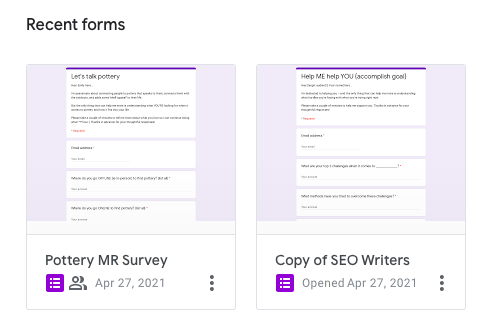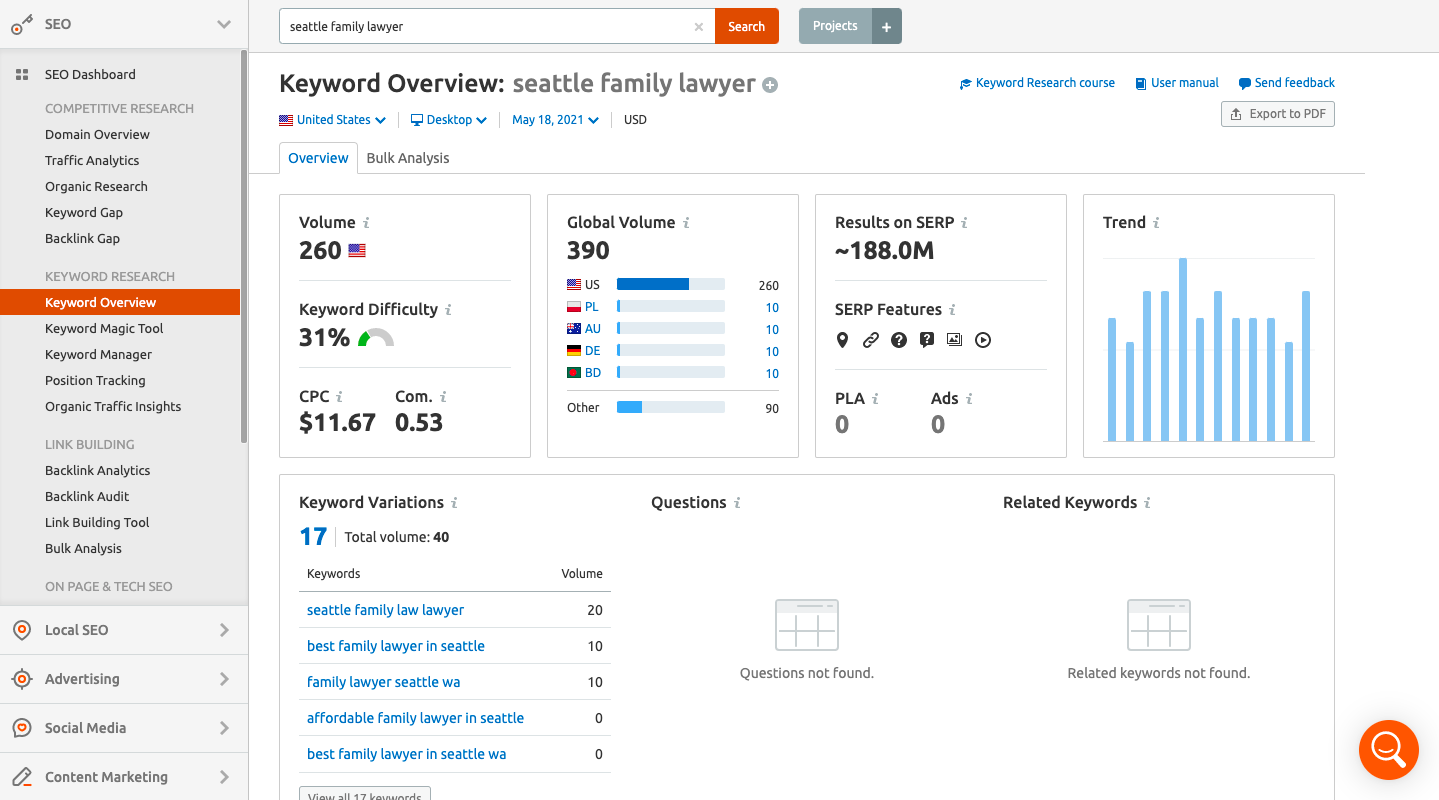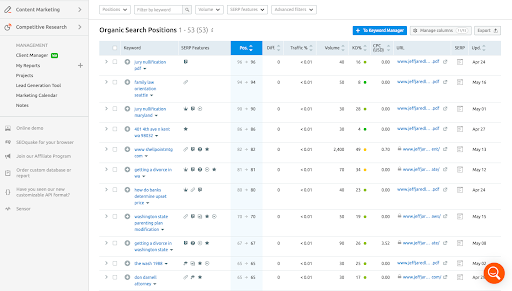Content marketing is a smart and effective way for law firms to reach more users and potential clients through their online content.
The benefits of law firm content marketing go far beyond social media likes and website traffic. In fact, content marketing can take on many different forms across various platforms, bringing in a wide range of benefits for law firms.
Here’s how to use content marketing to increase web traffic, convert more leads, and win over more law firm clients online.
Benefits Of Content Marketing For Law Firms
Some of the top benefits of content marketing for law firms include:
- Driving organic website visits through SEO content.
- Reaching more users on social media.
- Increasing website and blog authority.
- Generating backlinks from other websites.
- Growing an email list to run effective campaigns.
- Reaching more clients through video and webinar content.
- Acquiring leads via lead magnets and downloadables.
- Attracting local clients through localized content.
The benefits don’t stop there. By experimenting with different mediums, content marketing strategies, lead magnets, and more, you can use content marketing to bring a range of benefits to your firm.
How Law Firm Content Marketing Works
Many marketers oversimplify the content marketing process as “Create, Publish, Share,” which leaves many business owners wondering why their awesome content generates nothing but crickets.
The truth is, effective content marketing is all about creating the right content for the right audience at the right time.
At a high level, the law firm content marketing process goes as follows:
- Research. Conduct research to understand your target audience, how they search, what they are struggling with, and what topics they are interested in.
- Create. Create compelling content like blog articles, webpages, landing pages, ebooks, videos, webinars, podcasts, and more to drive traffic and generate leads.
- Promote. Distribute your content across channels such as your website, social media platforms, or your email list.
- Convert. Add calls-to-action (CTAs) to your content to entice users to contact you, fill out a form, or otherwise convert into a new lead.
- Measure. Analyze and measure the results of your content marketing efforts using analytics tools. Determine the ROI from your campaigns and optimize your content over time.
Law Firm Content Marketing Tactics
Now that we’ve covered the basics, it’s time to dig into the tactics that will bring your strategy together.
These are the 12 content marketing strategies you can use to generate more traffic and leads for your law firm.
1. Research Your Target Market
 Screenshot from Google Forms, June 2021
Screenshot from Google Forms, June 2021If your answer to the question “Who is your target audience?” is “Anyone with a legal issue,” then you don’t know your target audience very well at all.
Instead, you have a very vague idea of who you serve and why they’re looking to work with a law firm like yours.
Knowing your target audience from the inside out is key to creating content that resonates with them. Without audience research, you’re likely to create content that misses the mark completely.
Whether you decide to ask your audience these questions directly or create an official market research survey (we recommend Google Forms), here are a few questions you’ll want to be answered to better understand your audience:
- What is the most important legal issue you are facing at the moment?
- What resources have you looked into to help you solve this issue?
- What issues did you have with these resources?
- What is your #1 goal in overcoming your legal issue?
- What characteristics are you looking for in a law firm/lawyer?
- What methods have you used to find law firms/lawyers?
- What legal topics are you interested in learning more about?
Your audience’s answers to these questions will help you determine what topics to cover, what CTAs to use, and what keywords to target in your content.
Audience research informs your entire content strategy, so you don’t want to skip this step.
2. Conduct SEO Keyword Research
 Screenshot from Semrush, June 2021
Screenshot from Semrush, June 2021While market research gives you a glance into what your audience is struggling with and what they are looking for, keyword research tells you exactly what terms they use to find law firms like yours on Google.
Keyword research tools like Semrush or Ahrefs serve to provide valuable data around the keywords your audience is using, the competition level of these keywords, and how often they are being searched.
You can use these tools to find related keywords, research your competitors, find backlink opportunities, and more.
It’s best to use law firm SEO tools to find localized keywords that match your service area and the specific legal services you offer.
Make a list of keywords you might want to target on your site, and then determine whether they are a good match for webpages, blog articles, or other content assets.
3. Scope Out The Competition
 Screenshot from Semrush, June 2021
Screenshot from Semrush, June 2021This tactic involves spying on your competitors’ content strategies to inform your own content efforts.
Remember, though, that your competitors may have different target audiences; the insights gained from your market research should be at the front of your mind.
Here are a few ways to spy on your competitors’ content:
- Use SEO tools. Use SEO tools to search your competitor’s domain and see what keywords they are ranking for. Then you can add these keywords to your own content plan to build out new webpages and blog articles.
- Check out their blog. Scan through your competitor’s blog for interesting article topic ideas. You don’t want to copy your competitors directly, but you can write spinoff articles or gather ideas for what keywords to target.
- Review their webpages. Do your competitors have webpages that your site is missing? If the topics make sense for your site, it might be time to build out some new services or landing pages.
- Take note of their lead magnets. Are your competitors using lead magnets to gather email addresses, etc.? Get inspired and develop your own lead magnet ideas to generate more leads for your firm.
There’s a lot to be learned by seeing what your competitors are doing with their content.
Don’t copy what your competitors are doing exactly, but use their strategies as inspiration for your own content. Your goal is to go above and beyond what your competitors are already doing.
4. Align Content With Your Brand Narrative
Your brand narrative consists of your company’s values, mission statement, brand story, approach to client support, and other characteristics that make your law firm unique.
All of your content should be aligned with your brand narrative to cultivate brand authority and trust.
Your law firm can create a brand narrative as an internal document that your team can refer to whenever someone creates a new piece of content.
In this document, be sure to answer:
- Who is our target audience?
- What services do we provide?
- What makes us stand out from our competitors?
- What is our approach to working with clients?
- What is our brand story/foundation?
- What is our company mission statement?
- What are our values?
- What are the benefits (for clients) of working with us?
- What is our brand voice and tone?
- What is the goal (or goals) of our content?
As you might see, your answers to these questions will help ensure that your content aligns with your company’s values and works to speak to the unique needs of your target audience.
That way, existing and potential clients will come to trust your brand and know that they’ll always get the same signature experience when working with you.
5. Build Out Your Content Funnel
A content funnel consists of Top of Funnel, Middle of Funnel, and Bottom of Funnel content that moves users from the Awareness Stage to the Consideration Stage to the Decision Stage (respectively) of their buyer’s journey.
Top of Funnel
Top-of-Funnel content is informative content that addresses a topic at a high level. This includes your blog articles and guides that serve to draw in a wider audience that has broad questions about a particular legal topic.
Middle of Funnel
Middle-of-Funnel content speaks to users who are already “problem aware” and searching for a solution. They are likely comparing different law firm options, so they will want to see case studies, testimonials, in-depth guides, and service pages.
Bottom of Funnel
Bottom-of-Funnel content is the content that ultimately converts passive website visitors into new clients. This can include your service or landing pages, Contact Us page, or sales letter. These pages will include compelling CTAs to entice users to contact you.
Do you have content that aligns with every stage of the buyer’s journey? If not, potential leads might be falling through the cracks. Build out a content funnel to meet users at every stage.
6. Experiment With Content Types
Legal content marketing doesn’t have to mean strictly writing blog articles. In fact, it’s best to experiment with different content types to keep users engaged and see what works best with your audience.
Here are some content types to use in your content marketing:
- Blog posts.
- Interviews.
- Webpages.
- Landing pages.
- Ebooks.
- Videos.
- Webinars.
- Podcasts.
- Infographics.
- Courses.
- Resource guides.
- Email campaigns.
- Presentations.
- Graphic designs.
- Whitepapers.
- Case studies.
- Downloadables/PDFs.
- Newsletters.
- Flyers and posters.
- Paid ads.
- Pinterest graphics.
- Live video.
7. Create A Blogging Schedule
Publishing high-quality content is more important than churning out tons of blog posts per month, but it’s still recommended that you establish a blogging schedule so you’re able to stay consistent.
You can use project management tools like Asana to schedule your post assignments or simply use something like Google Calendar or Google Sheets to organize your topics.
Set a reminder for yourself for every step of the content marketing process: Research, Create, Promote, Convert, and Measure.
If you can only get out one article per month and a few social media posts per week, start there. Over time, you will get better at repurposing your content and scheduling your posts so you can reach even more users regularly.
8. Contribute Guest Posts And Interviews
Guest posting is a great way to attract authority-boosting backlinks to your website, which in turn can help you rank higher in the Google search results.
One way to land guest posting opportunities is to reach out to websites directly, asking if they accept guest articles. Most will do so for free, and many will allow you to link back to your site.
You can also land interviews and guest post spots through networking online or at in-person events. It never hurts to bump elbows with other industry professionals who might be willing to post about you on their websites.
Just be sure to only work with reputable websites with decent domain authority. Buying links or posting on spammy sites rarely improves your site’s authority in the eyes of Google.
9. Build Out Linkable Content Assets
Another way to attract links is to build out content assets. These are pieces of content that provide something unique and/or highly valuable, so other site owners are itching to link to them.
Some of the most effective content assets include:
- Ebooks.
- Exclusive interviews.
- Courses.
- Webinars.
- Infographics.
- Free tools/calculators.
- Resource libraries.
- Videos.
- In-depth guides.
You can attract links to these assets organically or by reaching out to publishers directly, asking them to check out your content and consider referencing it on their own websites.
10. Optimize Key (Service) Landing Pages
Landing pages, as we discussed earlier, most often serve as bottom-of-the-funnel content that converts visitors into leads. With this in mind, your landing pages should be optimized to the nines.
If you plan on driving organic traffic to your landing pages, then keyword research and on-page SEO are necessary. Make sure you are targeting searchable keywords and optimizing your page with SEO in mind.
Regarding conversions, your landing page copy should appeal to your target audience, hit on the perks of working with your firm, and include compelling CTAs to entice users to contact you.
Plus, a user-friendly design is essential to make your page easy to navigate and interact with.
11. Establish A Distribution And Promotion Strategy
You’ve created and published your content. Now what?
Every effective content marketing plan needs a distribution strategy as well. This covers where, how, and how often you plan on sharing your content.
Content sharing tools like Buffer help you automate some of this process by sharing your content to various social media channels. You might also have to make manual efforts to repurpose your content and share it with other platforms.
Here are a few places to share your content:
- Blog.
- Email list.
- Facebook.
- LinkedIn.
- Instagram.
- Twitter.
- Pinterest.
- Reddit.
- YouTube.
- Third-party sites.
- Social blogs (like Medium.com).
12. Measure Content Marketing Results
It’s painful to say it, but a recent case study that over 40% of law firms do not track their leads at all. Don’t let your firm fall under this statistic.
Posting your content is one thing, but you will need an effective means for measuring the results of your content to see if your efforts are working.
After all, the goal of your content is not just to generate views but to land a solid ROI on your marketing efforts.
Google Analytics can track website traffic, the source of your traffic, your website bounce rate, goal completions, and more to see how your web content is performing.
At the same time, most social media platforms have their own tools for measuring clicks, likes, engagement, and more.
In measuring the results of your legal content marketing, you should look at:
- Website page views.
- Goal completions.
- Website bounce rate.
- Social media shares.
- Social media clicks.
- Email open rates.
- Email clicks.
- Downloads.
- New subscribers.
- Form fills.
- Phone calls.
Go on to measure any metrics that are important to understanding the success (or failure) of your law firm’s marketing campaigns.
This is the only way to truly know whether your content is working to generate more traffic and leads for your firm.
Win More Clients With Content
Content in any form can be a powerful tool for increasing your law firm’s visibility online and winning over new clients. From blog articles to ebooks to video webinars, all law firms can use content to reach a wider audience across various platforms.
The above law firm marketing tactics serve to help you come up with an effective content strategy. This process starts with audience research, goes on to content creation, and ends with distribution and results.
Over time, your content will improve, and you’re likely to see an even greater ROI from your content marketing efforts.
More Resources:
Featured Image: Studio Romantic/Shutterstock
